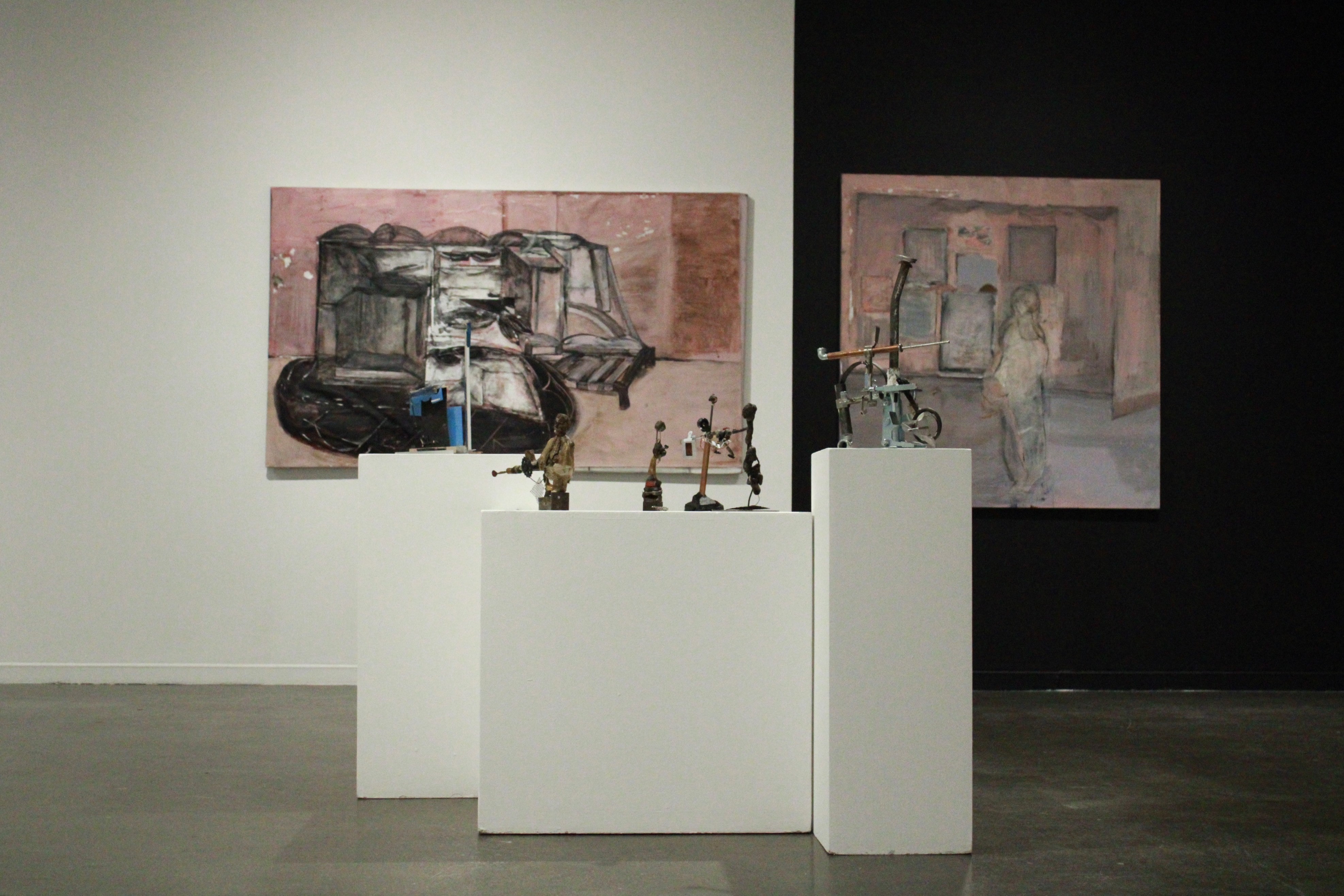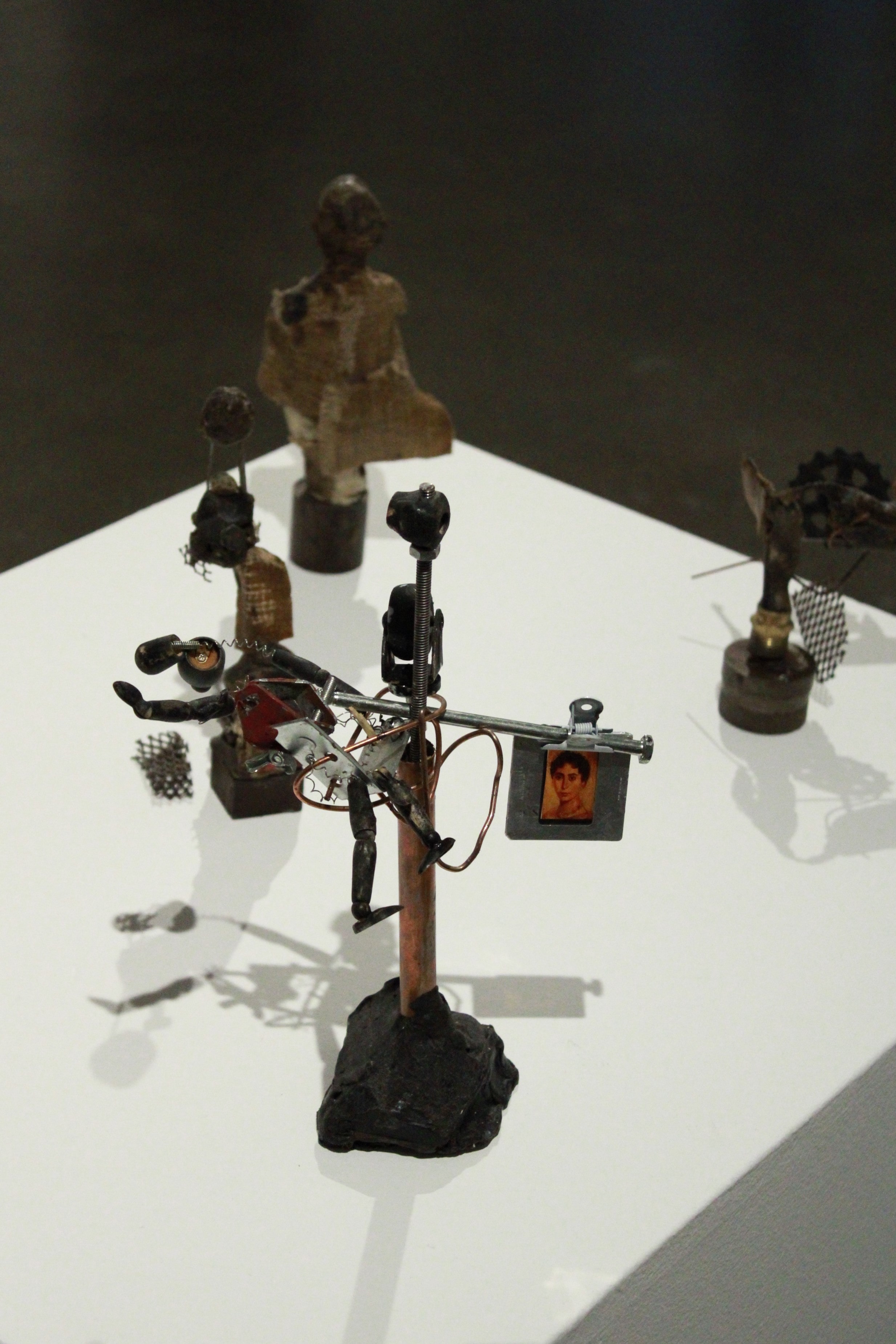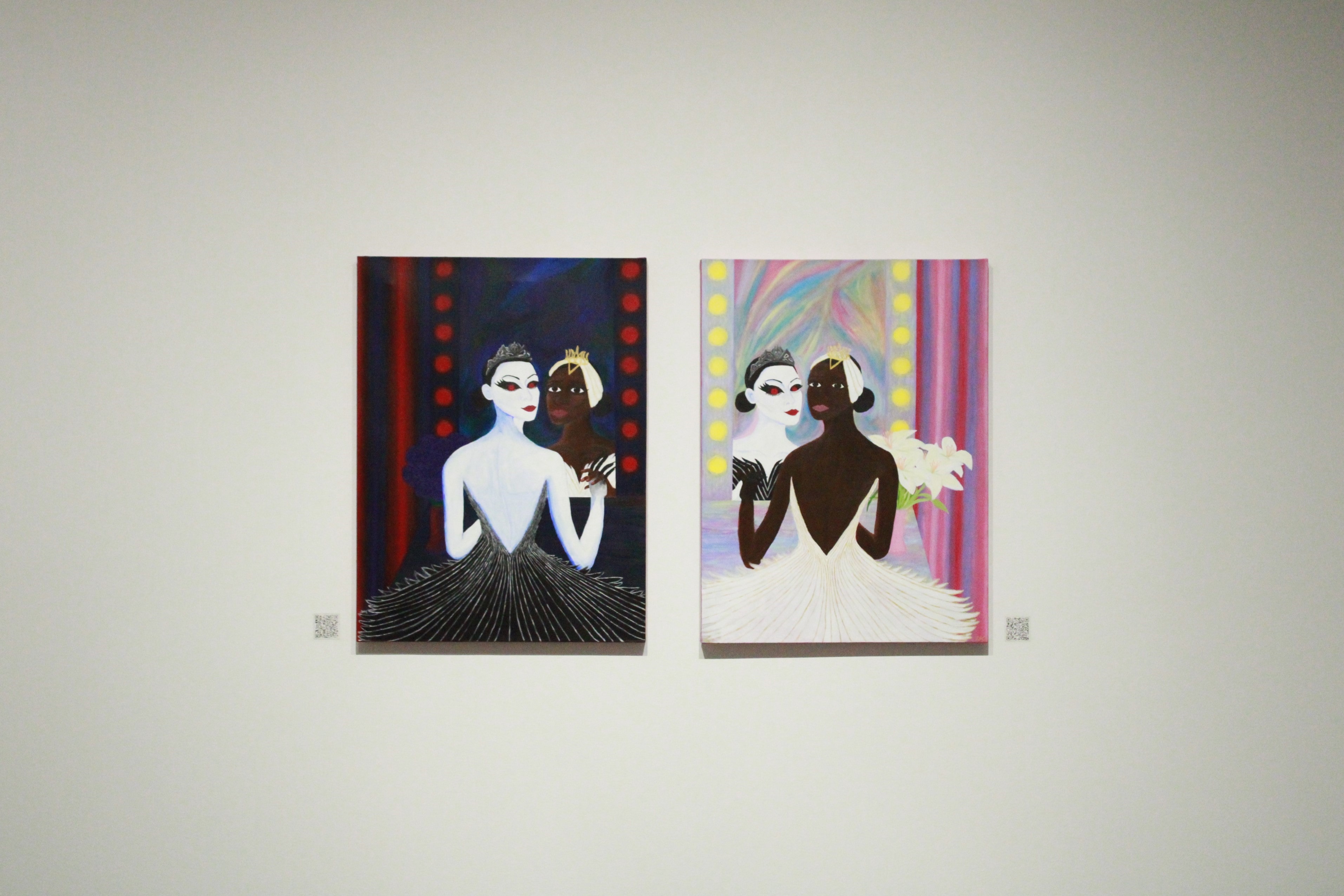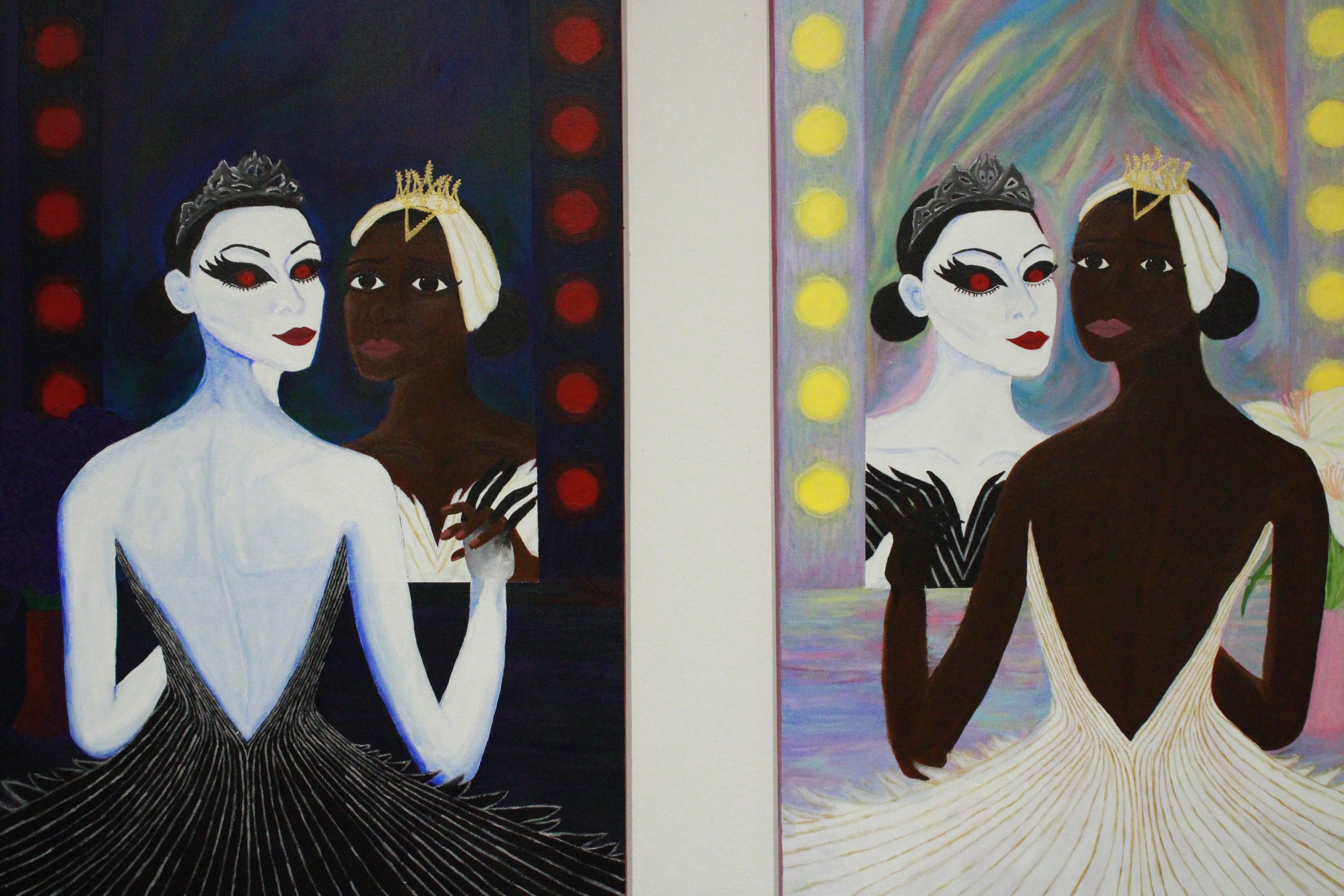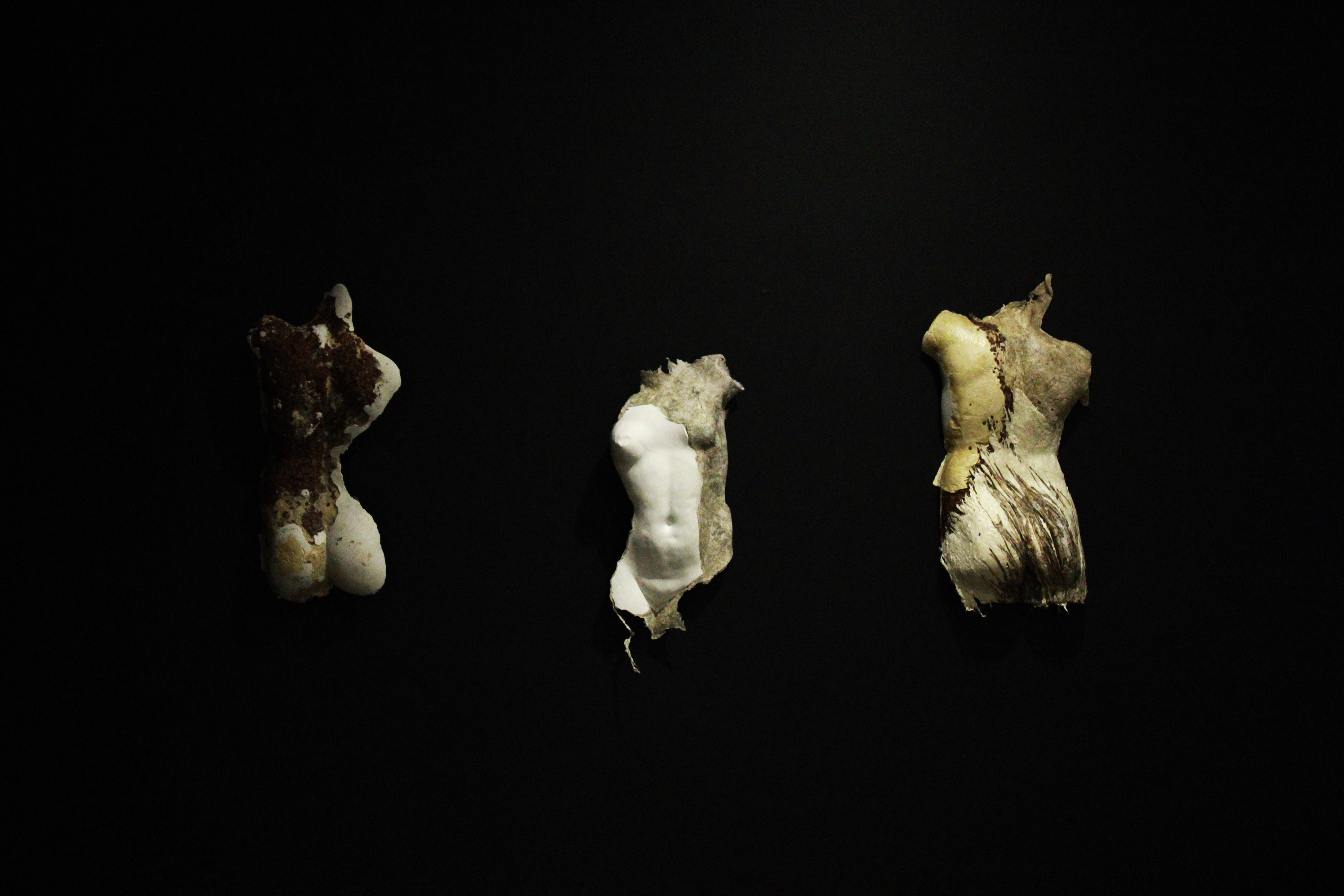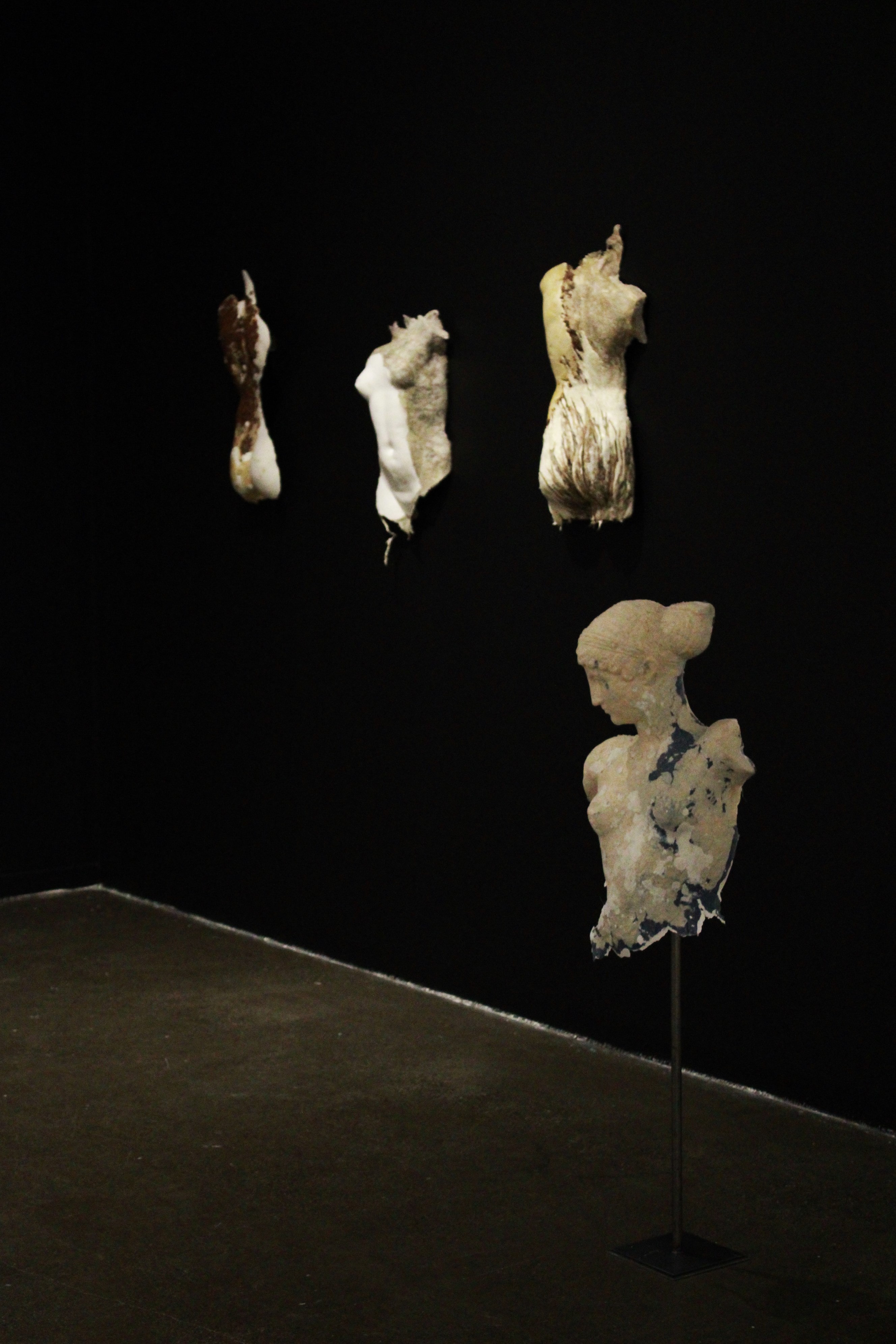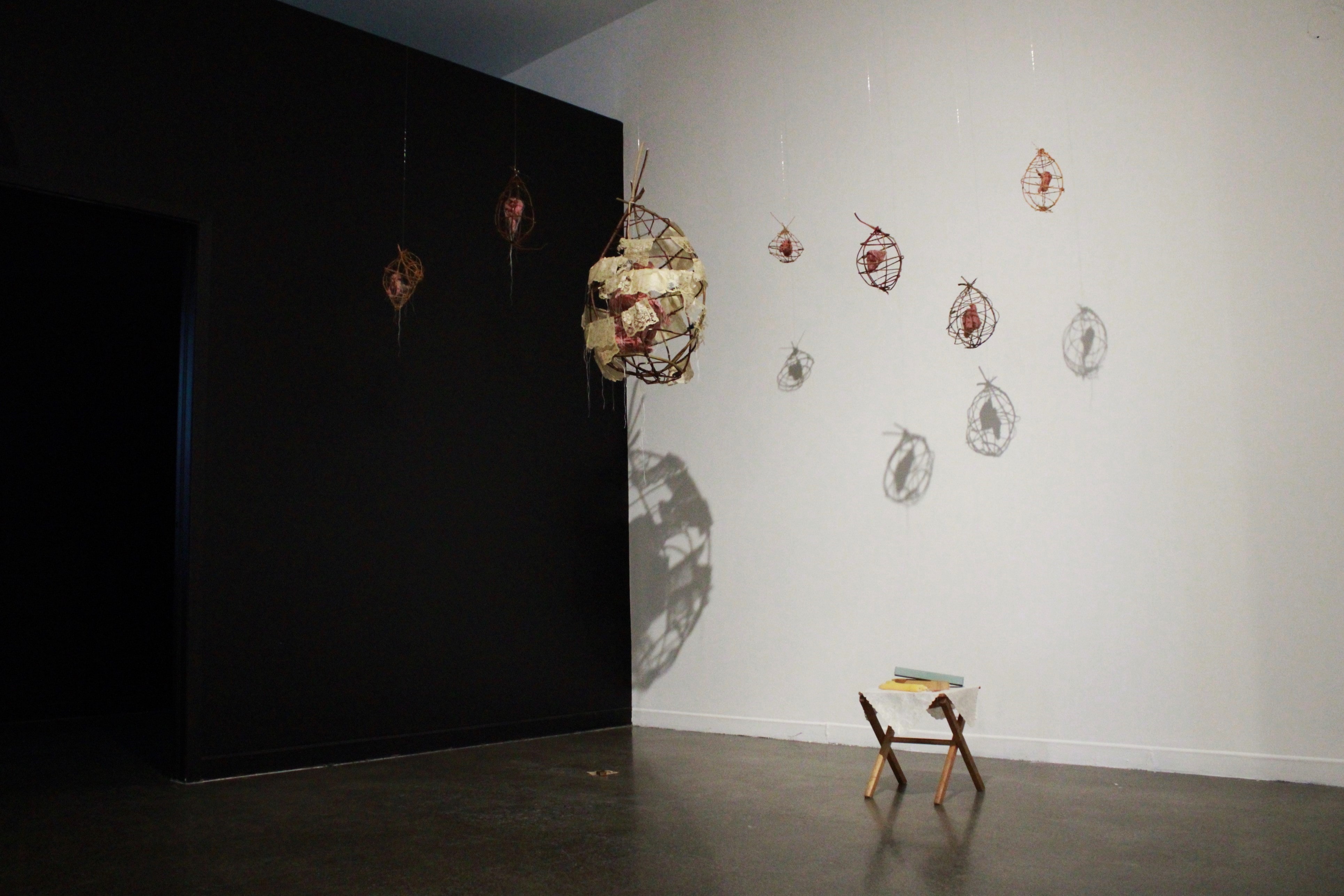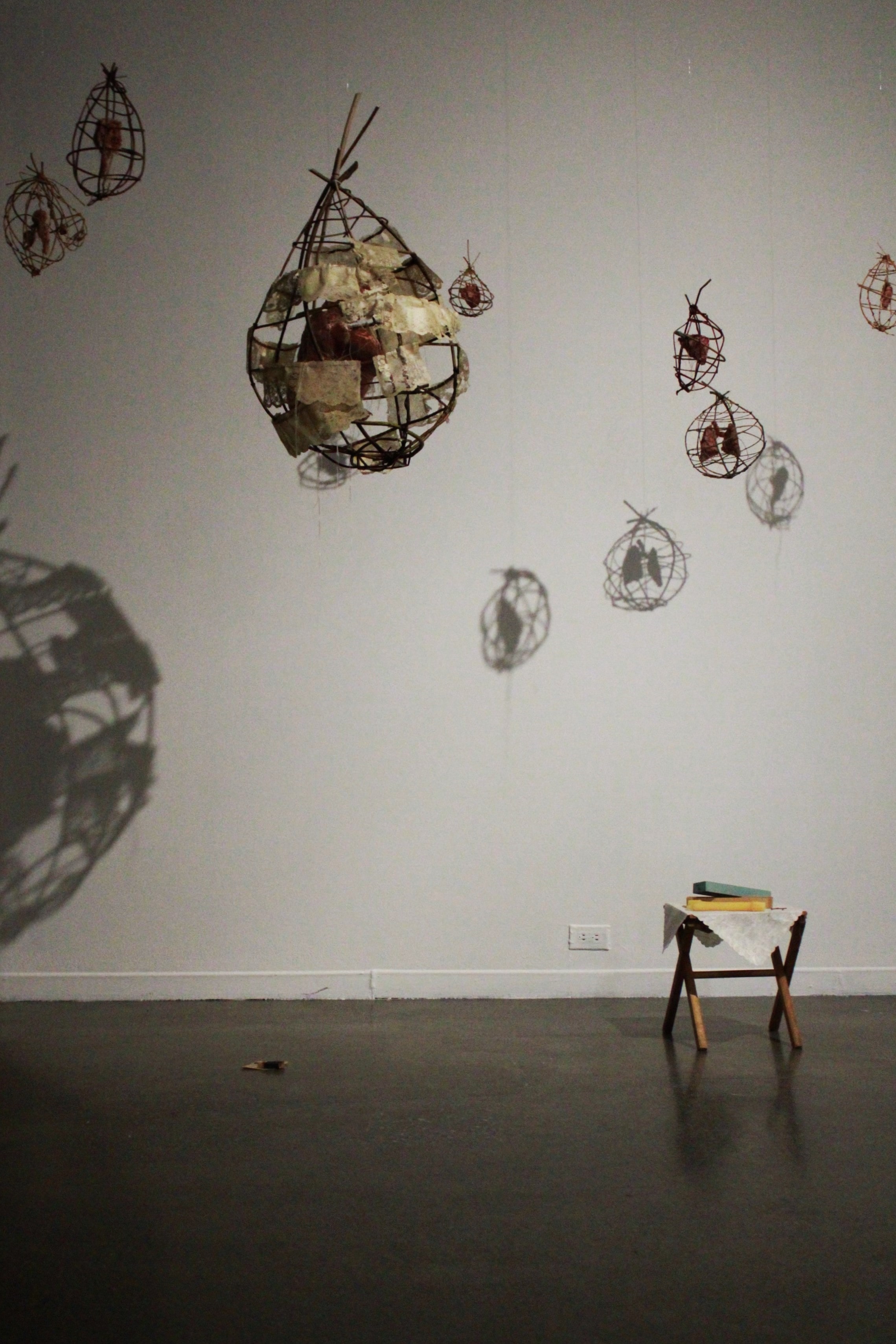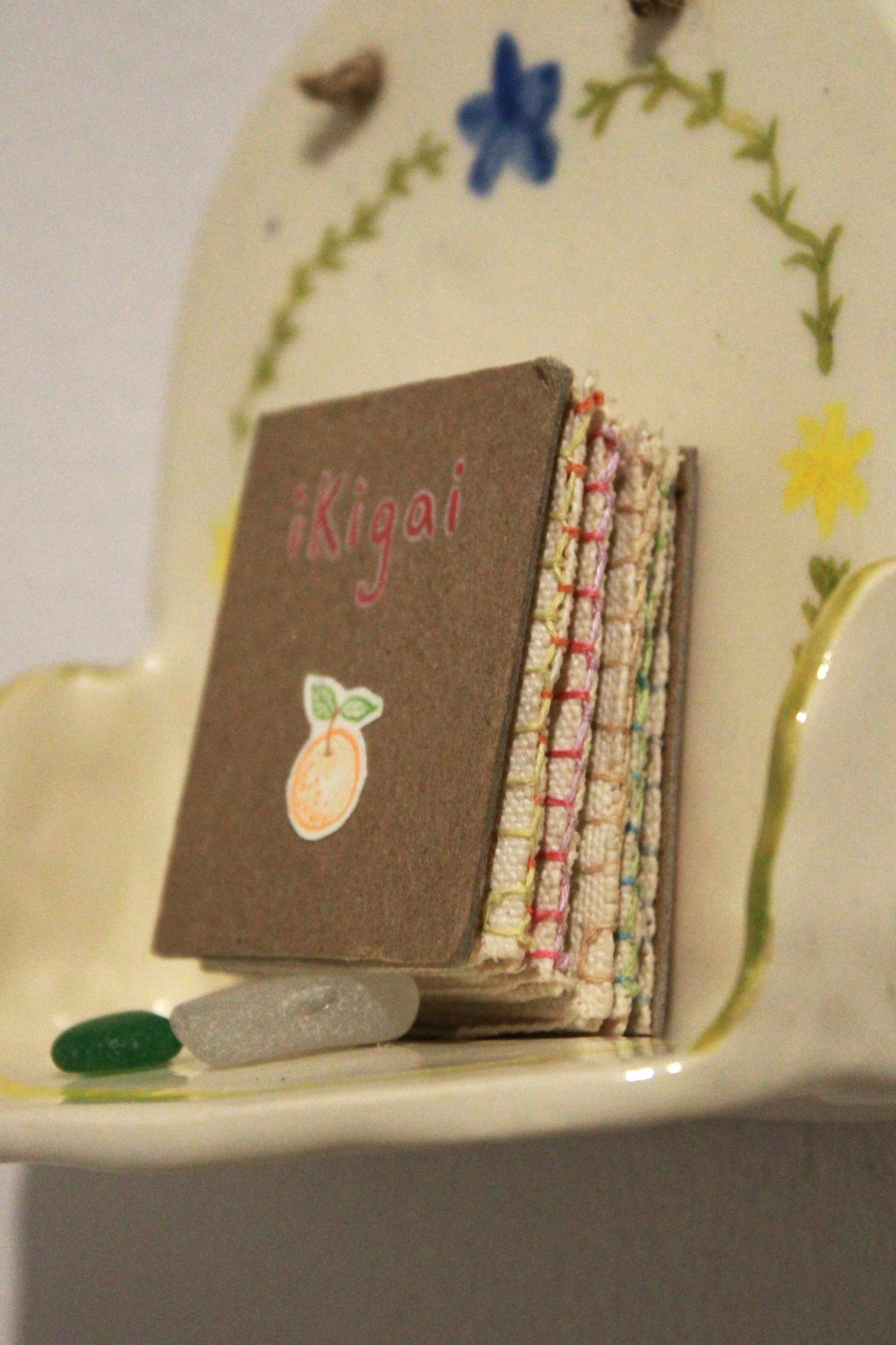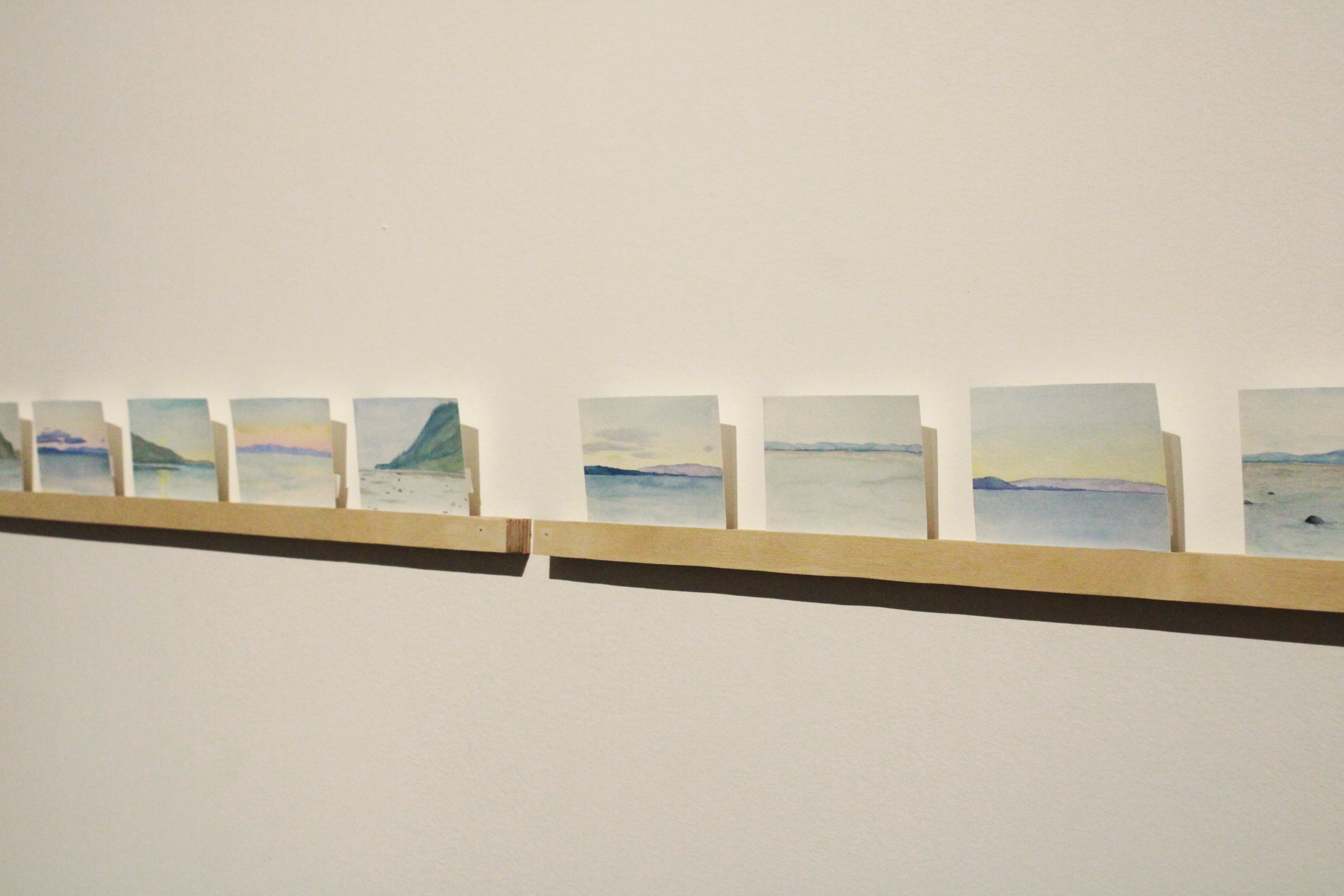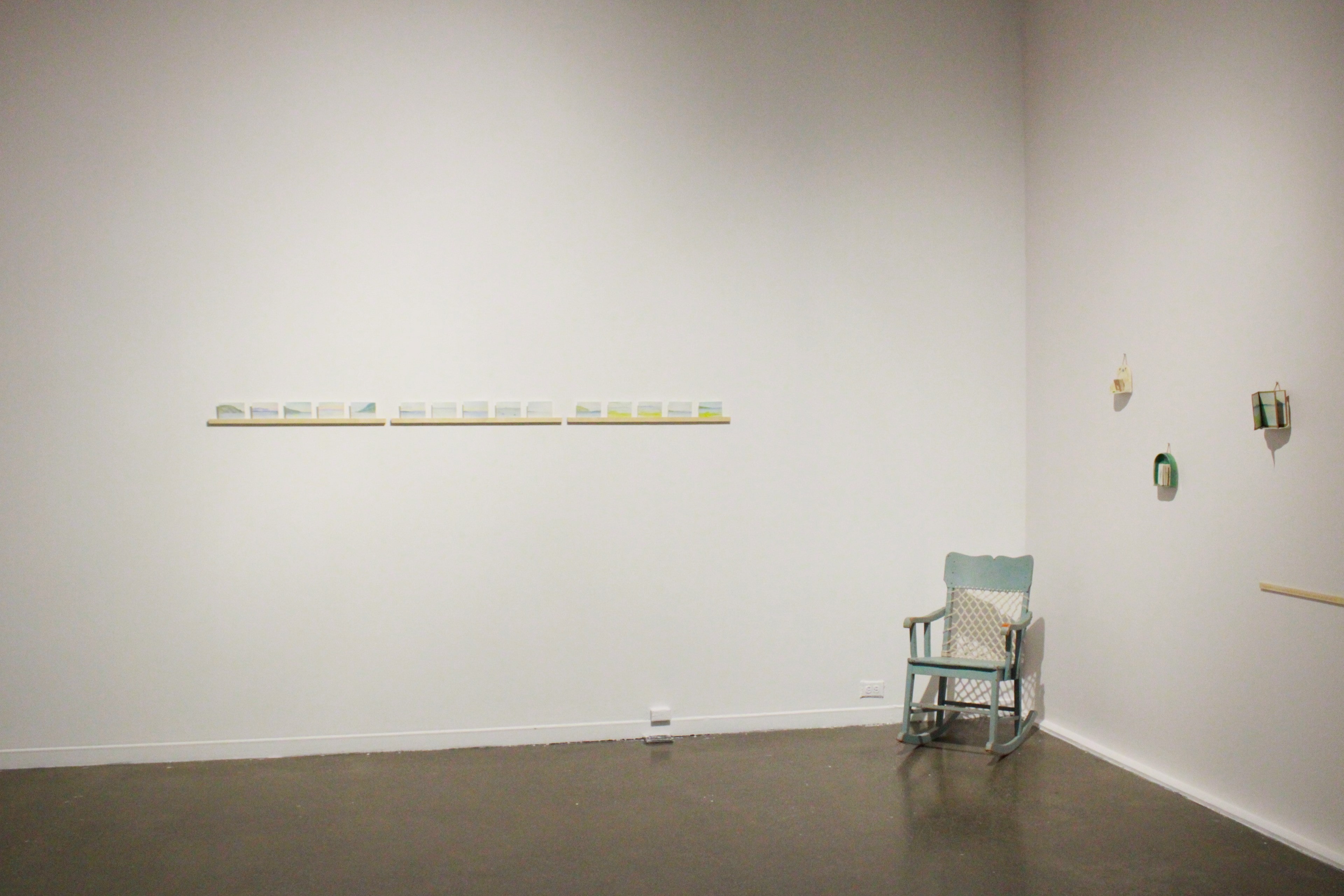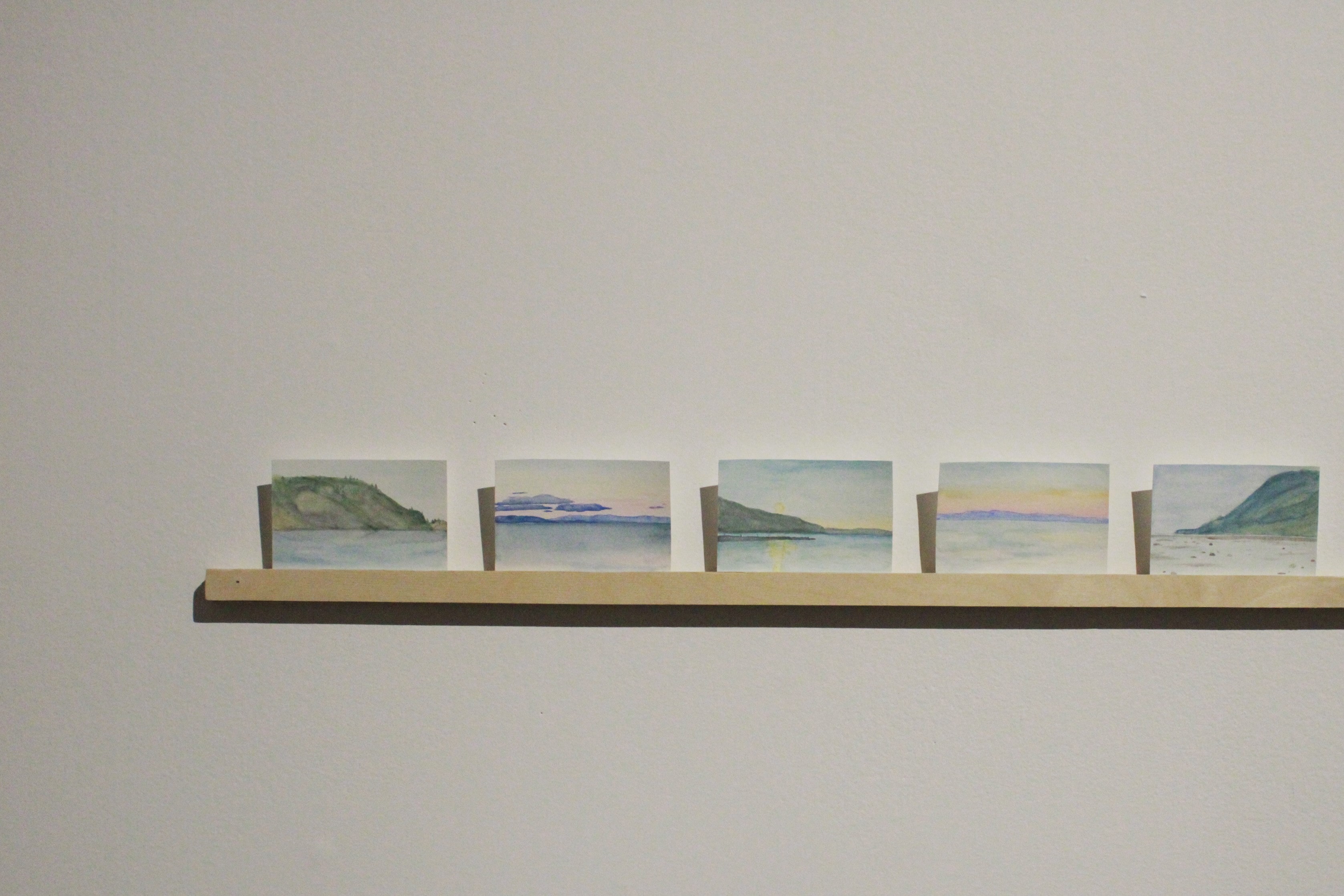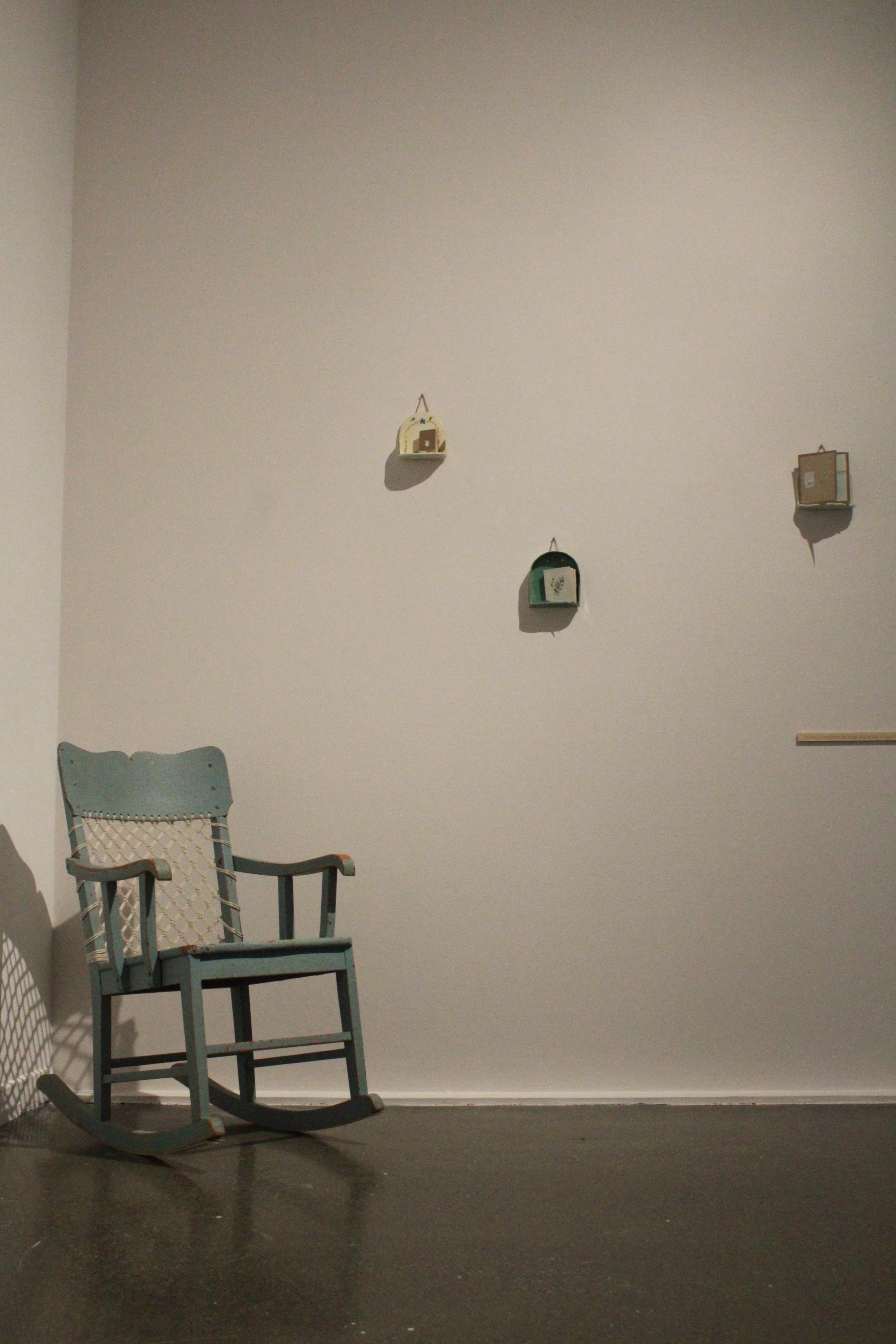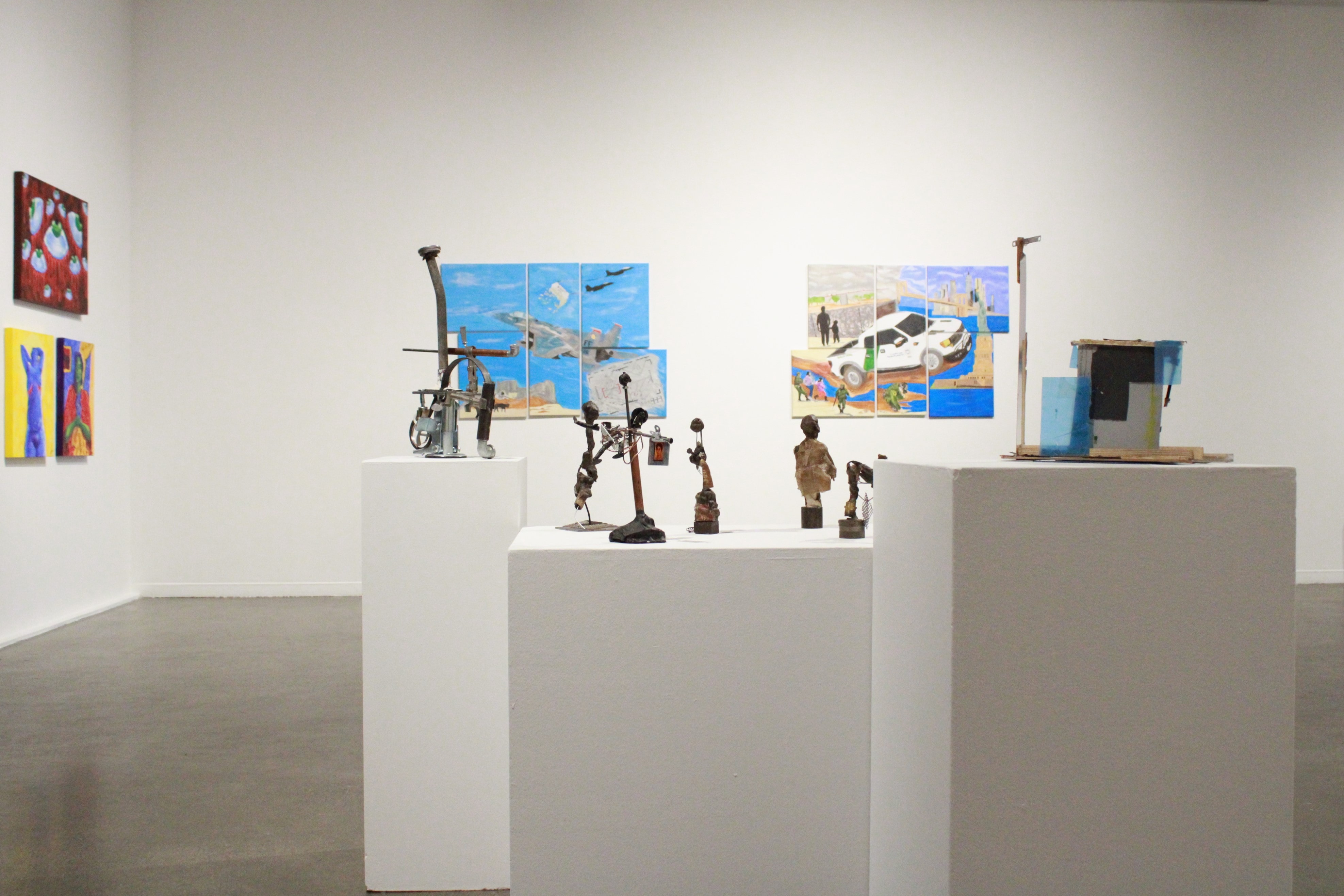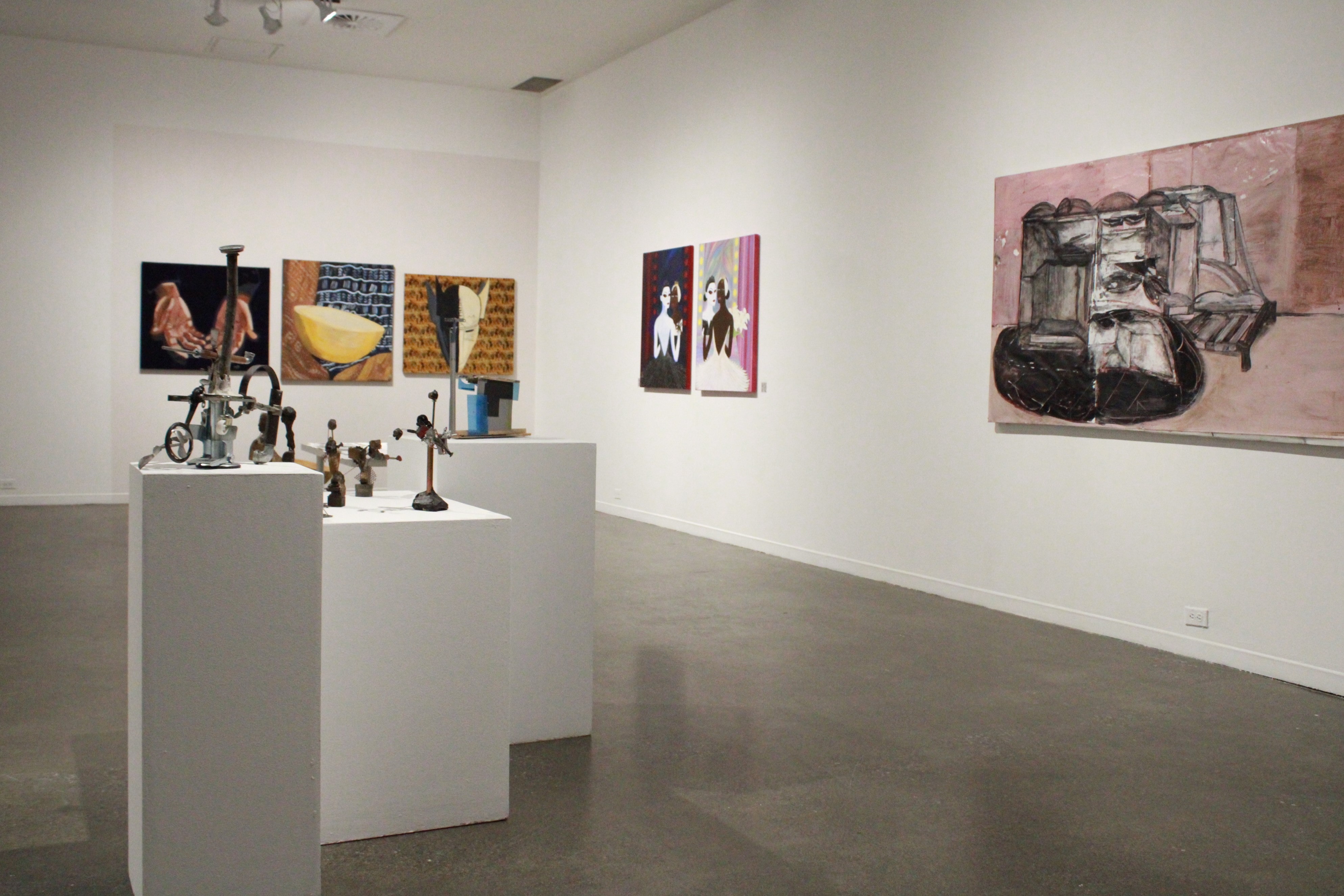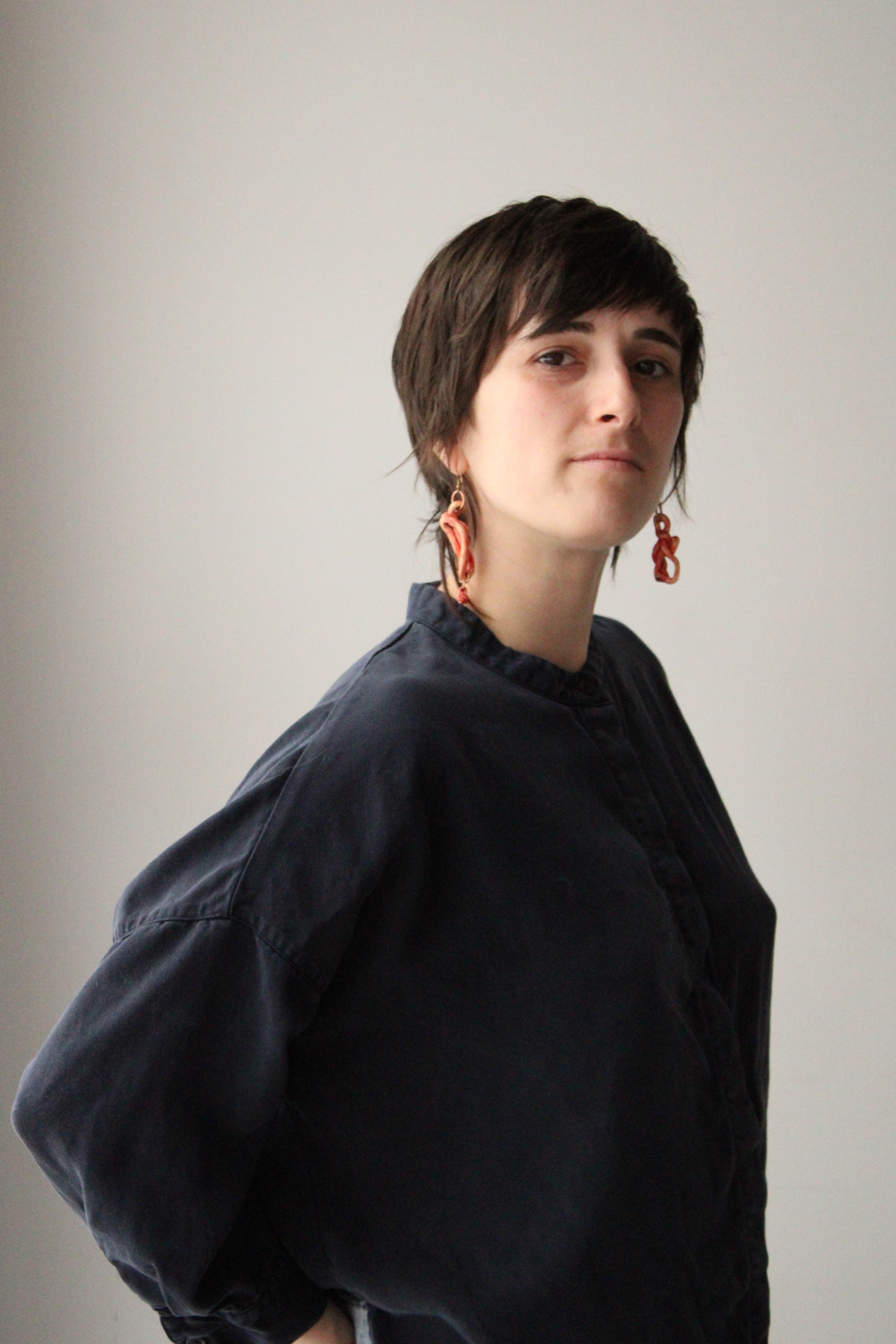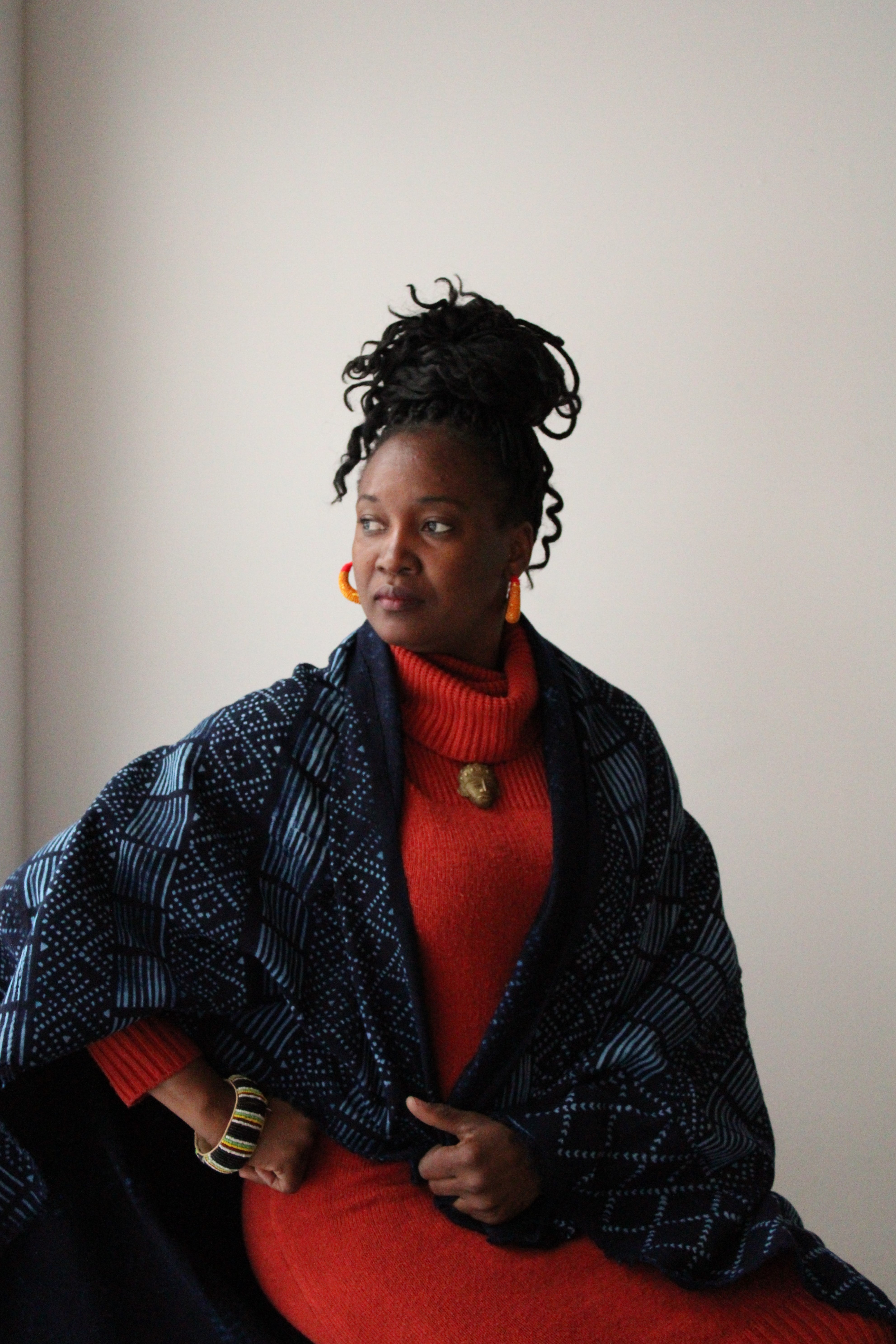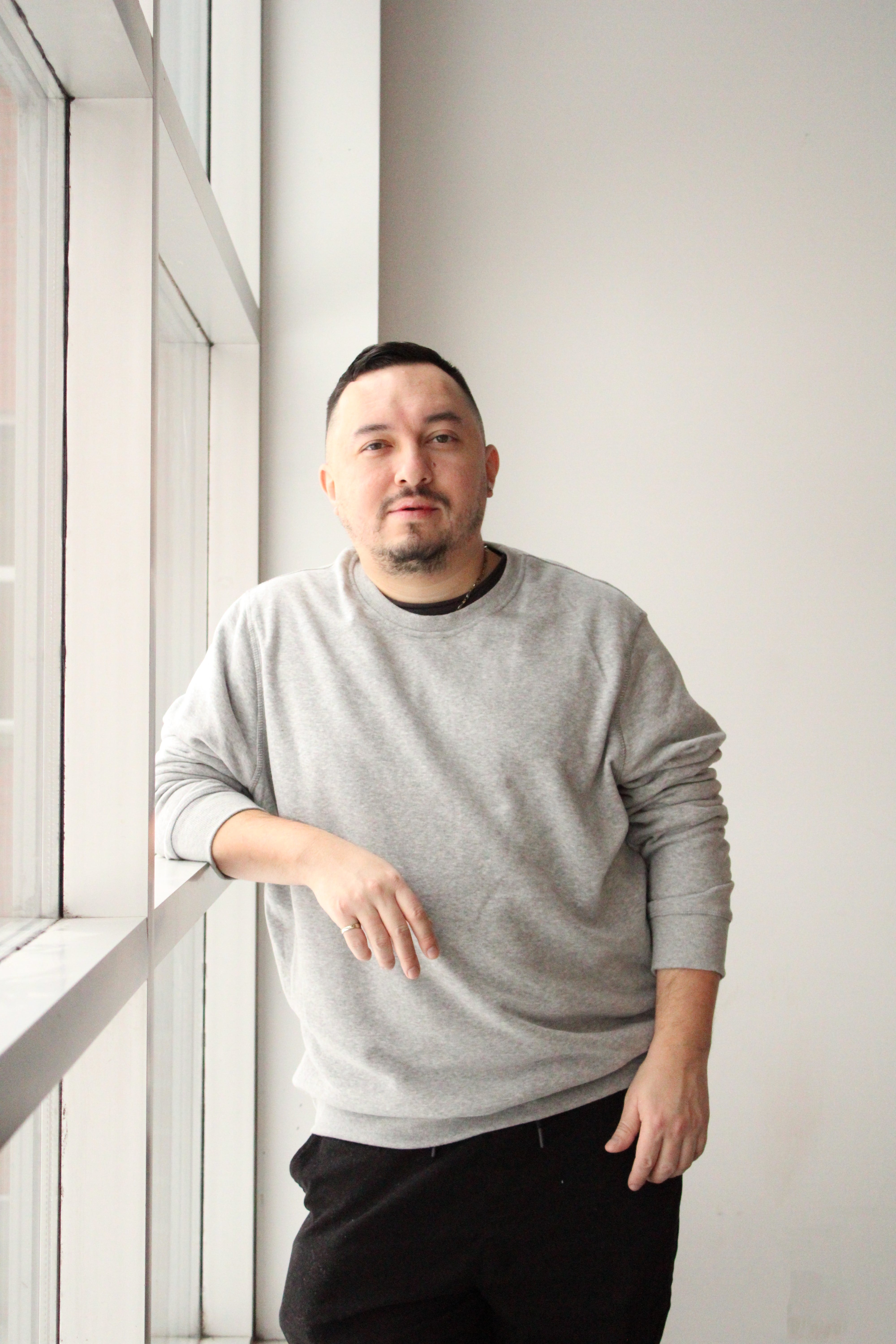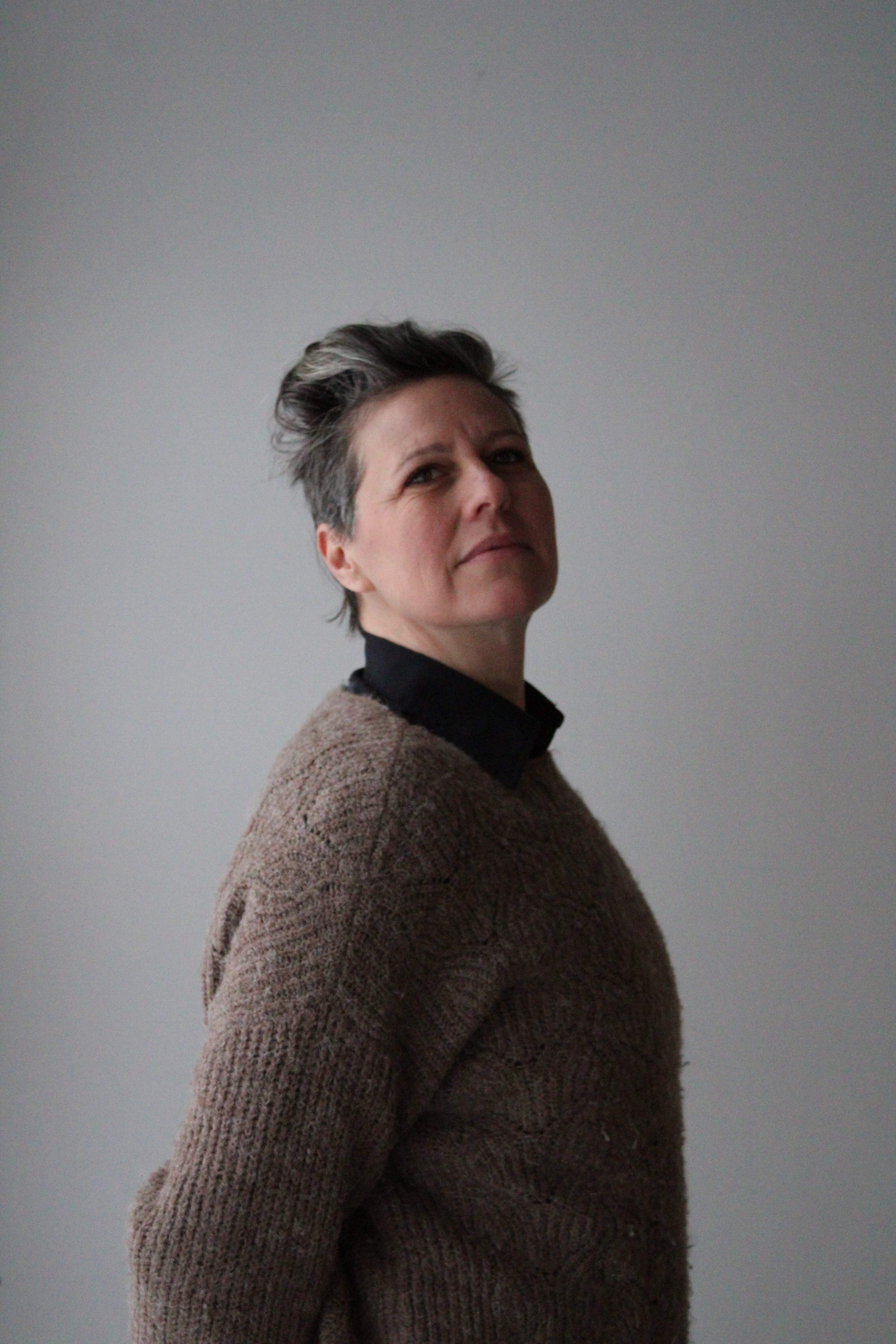“On those stepping into rivers staying the same other and other waters flow.”
Heraclitus
One need not be a student of philosophy to appreciate Heraclitus’ sentiments. The impermanence of our lived experiences is universal; life is in a constant state of alteration and the process of our becoming is unending. The journey of higher education, in its state of flux, makes it perpetually, willfully evident. The graduating students in this year’s exhibition are different people than those who arrived at this university a few years ago.
Read more
We arrived simultaneously curious and anxious, unsure of how to mesh within this new institution and with each other. Some sought changes that were laced with expectations, while others embraced openness to whatever experiences and ideas they encountered. For Fine Arts students there is the additional challenge that creating artwork publicly can be intimidating and revealing. But we came knowing that we would evolve, braced for the excitement of the future.
Throughout this journey of studying art, we learned more about our internal selves and how we interact with the world. Art expresses ideas, perspectives and emotions: it is an act of communication, an exploration of purposes and meanings, but more critically, it is an expression of what it means to be human. Pushing through insecurities and self-criticism, we lovingly inlaid our artistic processes with pieces of our selves. University is a place of transit, and we never planned for permanence. We absorbed new skills, both technical and critical, and were surprised by how we could employ them to articulate our ideas and emotions more effectively: a new vocabulary helping us connect with others. Our diverse perspectives inspired each other, and we learned together from our mistakes and our successes. The encounters we had changed us and our journeys.
This transformational experience forced us to wrestle with our limitations and to ponder who and what we aspire to be. It is a complicated affair to graduate with a degree in Fine Arts: it is only a first step in a complex path to earn the right to be considered artists professionally, yet is undermined by the indiscriminate usage of this title (artist) in mainstream culture. We are learning to face the actuality of a world that misunderstands and undervalues the specific contingencies of arts professions. Art appreciation by society is ever-changing, and making art can be incredibly powerful for self-expression while also remarkably frustrating when ideas fail in their materialization.
During the curation of this show, I was privileged to gain the trust of each participating student and be acquainted with their private processes: their approach to their work, their problem-solving skills and their inspirations. It has been a wonderful experience to witness them reveal themselves, to understand them on an intimate level and to look onto the prospect of reality after graduation together. It is an honour to be the organizing voice for such a wide breadth of talent. As diverse and layered personalities, these artists hail from different places, span generations, income levels, genders, sexualities, and politics, however none are immune to the inescapability of personal evolution.
Each participant expresses their individuality and reflects their previous life experiences and concerns in their artwork in unique ways. Gabrielle Gagné’s art is a catharsis that explores a traumatizing event and questions society’s expectations, while Camille Hétu’s is immersed in nature, quietly reflective but no less intense in pondering her personal transformations. Annika Morin’s pieces investigate the many facets we show others in dialogue with our inner complexities, and Christian Jimenez processes traumatic childhood memories and complex social issues through his painting practice. Both Alexis Nova Hazan Jepsen and Marie Constance Hountondji emphasize their heritage and explore colour as a tool to express their emotions, but to different ends: Alexis’ focus is a meditation on gender identity, while Marie Constance considers her nostalgia for Mali, her country of origin. Marie-Pierre Ranger questions our connection to our surroundings by investigating beauty using recycled materials and natural fibres, and Bashar Shammas dwells on the effects of architecture on the human condition.
Although their artworks are disparate, they all register their processes of becoming. It takes courage to choose this path and display one’s art, an external representation of the internal. The transition does not end with graduation, but is rather a chapter in a larger story. These budding artists are now facing the challenge of incorporating the complex identity of an artist into themselves and embracing what it means to them and to society. This exhibition experience will remain registered in time, but they will never step into these same waters again.
Juliana Frassetto, Student Curator
GABRIELLE GAGNÉ
Gabrielle Gagné received the Haystack Opportunity Fund for 2021-2022 and they will soon complete their Fine Arts degree with Honors.
Passionate about fiber art installation, paper making and book binding; their works are inspired by the testimony of human passage in the environment, home and relation to space, and trauma memory.
They look forward to being a professional artist and to teaching at the university level. Life is long, and they hope to open an artist center with workshops.
Artist Statement
Gabrielle Gagné creates paper installations using scavenged fibers and found objects to create a poetic narrative that explores the emotional relationship between people and their social environment.
They draw inspiration from their personal experience as a repressed lesbian raised catholic. Their work is about compulsory heterosexuality, gender and the physical traumas that can arise from suppressing oneself to comply with societal norms. The desire to please society and family can become greater than the need for a functional body. Fawning and dissociation are coping mechanisms, ways our bodies and minds have found to protect us. However, when they become the default way of being, it generates a dismemberment of personhood.
Gagné collects weeping willow branches to weave cages and uses handmade paper, from locally foraged fibers, to sew soft sculptures, reminiscent of damaged flesh. They utilize organic materials to create a fragmented self-portrait, in dialogue with found catholic objects from the area.
Gabrielle Gagné is influenced by artists who were not afraid to break taboos, such as Ana Mendieta and Louise Bourgeois. Their work confronts viewers with the fragility of the human condition. Likewise, Gagné opens a delicate conversation and offers the viewer an opportunity to contemplate life choices.
ALEXIS NOVA HAZAN JEPSEN
Born and raised in Mexico City, Alexis Nova Hazan Jepsen is in the last year of their Fine Arts degree.
Alexis finds inspiration in vibrant colors, surreal mindscapes, discovering beauty in the mundane and the liminal. Their preferred medium is painting, especially acrylic on canvas with a focus on brushstroke, texture, movement and on-canvas mixing.
A natural storyteller, they dream of becoming an author and painter.
Artist Statement
Alexis Nova Hazan Jepsen explores the connection between the physical world and the realm of emotion through vibrant colours and bold brushstrokes, telling an emotional story of what it means to embody a transitional space between gender, sexuality, and geography.
Originally from Mexico City, Hazan Jepsen grew up surrounded by vibrant murals and a deep appreciation for the arts. They found a passion for painting during their studies at Bishop’s University where they major in Fine Arts with a studio concentration and a minor in Creative Writing. They apply their love of storytelling to delve into questions of identity within the body, societies, and geographies they occupy. They work primarily with acrylic paint on canvas to create bold and colourful compositions that are the result of an intimate introspection of the self. Their work delves into the liminal, the spaces in between societal constructs of gender and country borders. Through paint they explore the emotional impact of existing in the in between: male and female, Canada and Mexico, metaphysical and corporeal.
Hazan Jepsen plays with the textures of paint as a potential to express deep and ever-changing emotion. The colours of their compositions rarely correspond to the literal subjects being painted, but rather are used to translate the physical, objective subject into a metaphysical and sensory image. They use the process of painting as a way of recontextualizing themself within the transitional: taking the strange experience of the interim and rendering it playfully in the vibrant colours of their home country and the expressive movement of their brush.
CAMILLE HÉTU (alias ÉMUE)
From Saint-Hyacinthe, Québec; Camille Hétu’s main inspiration is Nature. She is influenced by small objects from her surroundings and enjoys creating works that explore human emotions and our ability to be moved by things, to be amazed, and to wonder.
In her final year studying Fine Arts with honors in Studio Art, she is particularly fond of artist’s books, and loves to embroidery, draw with colored pencils and paint with watercolor.
Receptive to what life has to offer, Camille is in a stage where she values the unknown of what awaits her. She loves being surprised by where she ends up and what calls her in the moment.
Artist Statement
Camille Hétu’s (alias Émue) work explores the importance of slowing down and of noticing the wonderful details around us. It questions the value of going fast and brings forth the meaningfulness that can be found in contemplation and attentiveness.
Almost 4 years ago Émue decided to work for a summer in Baie-St-Paul, Charlevoix. As she stood in front of the Saint-Lawrence River everyday, inspiration flowed through her. Making art became an integral part of that season. Through her art, Émue tried to capture the significance of the nature that surrounded her, from the tiniest detail to the grandeur of the Saint-Lawrence River. Since then, her attachment to this river keeps on finding its way in her artistic practice.
As she meticulously makes artist’s books, Émue feels like she can express herself in the sincerest way. The minutiae of her books represent the unexpected significance that can be found inside. The soft colours of her watercolours speak to the calm sense of contemplation when looking at the Saint-Lawrence River. Her care for details is tangible in her tiny embroideries.
When Émue encounters delicate flora, she approaches it with singular focus. She holds it in her hands, observes it, and sits with it. When we encounter her artwork, Émue wants us to feel the same way she does when noticing a subtle segment of nature. Her work calls us to contemplate, pay attention, and listen.
MARIE CONSTANCE HOUNTONDJI (alias SIRA)
Born and raised in Mali (West Africa), Marie Constance has won the Rozinsky scholarship and is completing her degree in Fine Arts.
Her paintings and sculptures are inspired by fabrics, colors, Surrealism and Expressionism. In her practice, she is drawn to themes of world evolution, the supernatural and the diversity of ethnic beliefs.
After her degree, she plans to work as an artistic director.
Artist Statement
Marie Constance Hountondji (alias Sira) is Malian of Beninese origin. She is completing a double major in Arts Administration and Visual Arts at Bishop’s University. She deepens her practice by exploring different mediums to find a meeting point, in the image of the loincloth.
Textiles, painting and sculpture are her preferred techniques. Sira chooses these approaches to pay homage to the loincloth (N’fini), a piece of cloth made from plant material and spun and woven by women. It is used to cover the body (Soutoura). As well as being used for clothing, the loincloth is also a means of communication in most West African countries, thanks to the motifs it incorporates.
Sira’s childhood memories are imbued with the various symbolic and cultural uses of the N’fini. The life cycle of women is marked by the loincloth, from birth to death.
Sira’s art is influenced by the beauty of these textiles and by the ancestral messages they convey within society. In association with other media such as painting and sculpture, Sira seeks to enhance its meaning, commemorate the loincloth’s traditional heritage and underscore its contemporary relevance.
Here, the loincloth acts as a canvas on which traditional cultural and spiritual thematic compositions coexist. The loincloth, so central to Sira’s life, so precious, becomes, through this practice, the most important element in her work.
CHRISTIAN JIMENEZ
In his final year of a Fine Arts bachelor, Christian Jimenez was born in Colombia, where he lived until he was 11 years old, then moved to the USA and now resides in Canada.
His artwork addresses current life events, music, history and sports. And his favorite means of expression are drawing, painting and tattooing.
Christian aspires to earn a living by selling paintings and drawings, while working as a tattoo artist.
Artist Statement
Since the beginning of his artistic practice, Christian Jimenez has been creating art to question what we are becoming as human beings. Influenced by his experience of growing up in Colombia, he brings his own perspective on current world events that impact people significantly. Societal issues such as crimes, poverty, war, immigration and poor government management are recurrent themes.
He was introduced to painting at Bishop’s University which quickly became his preferred medium, along with drawing. Taking studio courses has helped Jimenez to better express his ideas by learning about compositions and techniques and, in turn, creating more interesting pieces. Using acrylic paints he creates colorful contrasts and shadowing effects on canvas. While being introduced to new artists during art history classes, the works of Diego Rivera and Fernando Botero have encouraged Christian Jimenez to tackle difficult subject matter.
Jimenez’s process is to use multiple canvases as visual chapters that, when interconnected, tell a narrative. By addressing universal issues, he hopes that the viewer will identify with the stories represented.
ANNIKA MORIN
Originally from Austin in Quebec, Annika Morin is completing her degree in Arts Administration and Fine Arts with a concentration in Studio.
Inspired by nature, the body and vivid colors, Annika expresses herself with graphic artwork and is discovering new ways of spicing it up. Her favored mediums are acrylic painting and drawing with either graphite pencils or charcoal.
Upon graduation, she hopes to work in an arts museum either as a curator or as an artistic director.
Artist Statement
Annika Morin’s artworks carry a sense of fantasy, with a touch of nostalgia found in the intricacy of her themes. Her painterly compositions convey a sense of stable symmetry, and explore the themes of reflection and dualism, capturing the different facets of oneself. They also have harmonious color palettes, creating contrasts that drive the eye to elements on the canvas.
Her work stages a Manichean world where opposites face each other, such as the White and the Black Swan, or the demon and the little girl. Morin’s work undeniably investigates the conflicting aspects we show to people and our inner complexities, using distinctions between light and dark to her advantage.
Fantasy and polarities are two concepts that the artist was drawn to ever since a young age, when fantasy books were her main source of escapism. The idea of something reaching beyond reality has always been far more alluring than day-to-day life, even more so when there is a clear opposition between good and evil. It was intriguing to see in the books how the question of righteousness was adjudicated, and to which side characters and things fell according to virtuous criteria. The different visual features of painting, charcoal, and printmaking call to her the most when she thinks of mediums to depict such a polarized worldview.
MARIE-PIERRE RANGER
Coming from Quebec, Marie-Pierre Ranger has Danish, French and native American roots. She is 48 years old, lives in Magog with her three teenagers, and is about to complete her degree in Fine Arts.
Marie-Pierre is moved by beauty, the environment and the impermanence of materials, especially fiber. Open to new discoveries, and to see where the process will lead her, she is passionate about molding and sculpting with fiber.
Her dream career is to become a sculptor with the mission of creating spaces for artists to practice. She questions the status quo and considers how a career in arts could be as important as in business.
Artist Statement
Marie-Pierre Ranger’s work is an investigation of beauty using recycled materials and natural plant fibers. She sculpts in a manner that questions the classical ideal of beauty. By choosing to cast Venus Esquiline, a Roman goddess embodying love and sexuality, Ranger’s process instigates a deeper reflection of her personal definition of beauty and how it creates inner narratives women have toward their own body.
Ranger’s work not only reflects on the unattainable idealistic Venus but it addresses the passing of time, the evolving definition of beauty. Her foraged plants from the local environment and discarded materials such as denim are transformed into pulp, paper and fibers. The recycled denim, with its history of resilience and strength, becomes a metaphor for the enduring strength women carry towards the imposed challenges of societal expectations. Each worn and repurposed garment carries the imprints of past narratives, symbolizing the lived experiences that shape our identities. The juxtaposition of local plants and this humble material against the backdrop of an idealized Roman goddess serves as a critique to contemporary beauty standards women carry.
Ranger exposes the transformative power of embracing one’s authenticity, rising above societal norms, and reclaiming ownership of our bodies with all of the imperfections that come with maturing. Like our skin, these materials inscribe the organic reality of being a woman.
Let us degrade; let women be cast in fibers and pastes, not marble and stone. On some days it is a joy to celebrate womanhood, and on others it’s more difficult to remain positive. Being ephemeral is fine, and so is being fragile. Being stable and forever young shouldn’t be a requisite of contemporary beauty.
BASHAR SHAMMAS (REFUGEE)
An ardent painter, Bashar Shammas left Syria in pursuit of better opportunities in Canada, where he is now completing his Fine Arts degree.
Bashar is always open to experimentation with all mediums and techniques while reflecting about the human condition and drawing inspiration from architecture that is not profound, and all kinds of sketches and drawings.
After graduating he envisions a career as a professional painter.
Artist Statement
“I ride solo like a fighter jet” Action Bronson
A refugee and a post-war painter, Bashar Shammas is deeply rooted in the Syrian traditions of figuration. He grew up between the vibrant and refined culture of Aleppo and the impact of war’s powerful imagery. These memories shaped his painting practice and his vision of art as both creation and destruction.
Because words fall short when trying to explain his own perception of beauty; painting, drawing, and sculpture have become his main languages of communication and self-expression. His most thorough ideas come from these mediums. He relies on restraints, using few gestures, pattern of lines and limited palette while dealing with a level of subjectivity. Shammas feels free with these restraints.
Bashar Shammas plays with the interaction between figuration and abstraction. His imagery is based on unfamiliar and unrefined places as well as places from the subconscious, always open for interpretation. He intends to make his work appear as real places based on his own perspective of what a real place could be. Keeping the origins of his images and figures authentic even when the space is something invented from impressions and brush strokes.
We would like to extend our deepest thanks to the Bishop’s University Students Representative Council (BUSRC); Dr. Stine Linden-Andersen, Dean of Student Affairs; Dr. Jean Manore, Dean of Humanities; Dr. Andrew Webster, Vice-Principal Academic and Research; Dr. Darren Millington, Interim Chair, Department of Fine Arts; and the Bishop’s University’s Alumni Association for their generous financial contributions. We are also very grateful to Sonia Patenaude, Manager of Communications and Justine Trempe, Social Media Officer for their tremendous help with our fundraising campaign.
We would also like to acknowledge the close collaboration between the Foreman Art Gallery and the Fine Arts Department of Bishop’s University in the coordination of this project. A very special thank you to the Fine Arts Department Technician Brenna Filion for her support and dedication throughout the organization of this exhibition.








